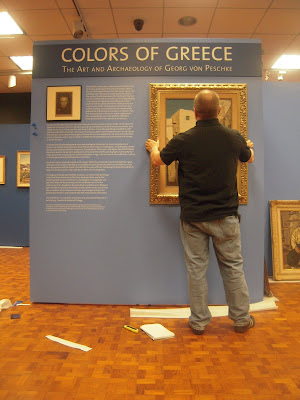
Restoring old plaster involves those magic plaster washers that only
Kilian's at Chestnut Hill carries. Loaded with plaster washers and heavy bags of plaster dust, I decided to take the long way home, and drive the entire length of Germantown Avenue, one of my favorite American streets (where you can see the discordant clash between the 18th and 21st centuries).
At 4909 Germantown Ave. I came across a monument that I had never seen before, the gate for the Hood Cemetery. It was designed by William L. Johnston in 1849-50. Although Baroque in every other respect, it features a horse-shoe arch of clear Islamic origins. Thus, I have found another specimen for my collection of Islamic Philadelphia (see
here). And as far as I can tell, this is the earliest example of this genre and predates the other examples by two decades. This early instance suggests that an Orientalist iconography first entered Philadelphia via funerary architecture. Browsing through the Fine Arts Library at Penn, I also discovered a 1968 dissertation that deals with Islamic influences in American architecture: Gerald S. Bernstein, “In Pursuit of the Exotic: Islamic Forms in Nineteenth-Century American Architecture,” University of Pennsylvania, Ph.D. dissertation (Philadelphia, 1968)
Here is my ongoing list of Islamic Philadelphia monuments:
William Johnston, Hood Cemetery Gate, Germantown (1850)
Vorhees Mausoleum, Laurel Hill Cemetery (1861)
Benson Mausoleum, Laurel Hill Cemetery (1868)
Frank Furness,
Gibson House (1870)
Frank Furness,
Rodeph Shalom Synagogue (1871)
Herman Schwarzmann,
Horticultural Hall (1876)
Wilson Brothers, Joseph T. Potts House (1876)
The image above is from the official
HABS survey of the monument. The photo was taken by Jack Boucher, ca. 1973.
 The festivities began with my lecture, "Georg von Peschke: The Archaeology of Greek Life."
The festivities began with my lecture, "Georg von Peschke: The Archaeology of Greek Life." With Tracey Cullen, editor of Hesperia. In 2007, Tracey insisted that I track down the Peschke estate in order get copyright permission to use a Peschke reproduction. This lead to my discovery of the Peschke family in California and the beginning of a wonderful relationship.
With Tracey Cullen, editor of Hesperia. In 2007, Tracey insisted that I track down the Peschke estate in order get copyright permission to use a Peschke reproduction. This lead to my discovery of the Peschke family in California and the beginning of a wonderful relationship. With Brian Wallace, the new Curator and Academic Liaison for Art and Artifact Collections at Bryn Mawr College. Brian began his new job in January and inherited the project in process. He shepherded its completion victoriously. I'm proud that this was his first show at Bryn Mawr.
With Brian Wallace, the new Curator and Academic Liaison for Art and Artifact Collections at Bryn Mawr College. Brian began his new job in January and inherited the project in process. He shepherded its completion victoriously. I'm proud that this was his first show at Bryn Mawr. Pamela Sinkler-Todd (daughter of Homer Thompson and Dorothy Burr Thompson) with Marianna Monaco (daughter of Georg von Peshcke).
Pamela Sinkler-Todd (daughter of Homer Thompson and Dorothy Burr Thompson) with Marianna Monaco (daughter of Georg von Peshcke). Of course, none of this would have been possible without the support of this lady, Celina Gray
Of course, none of this would have been possible without the support of this lady, Celina Gray The genius of Steve Tucker, exhibitions designer. Steve has done extraordinary projects at Bryn Mawr, the Rosenbach Library, the Philadelphia Library Company, etc.
The genius of Steve Tucker, exhibitions designer. Steve has done extraordinary projects at Bryn Mawr, the Rosenbach Library, the Philadelphia Library Company, etc.






